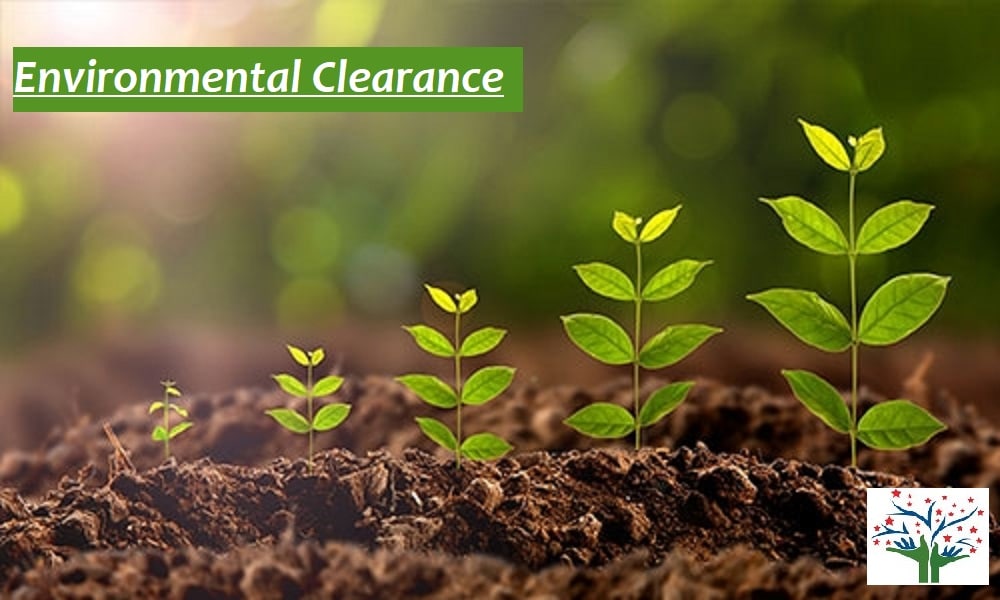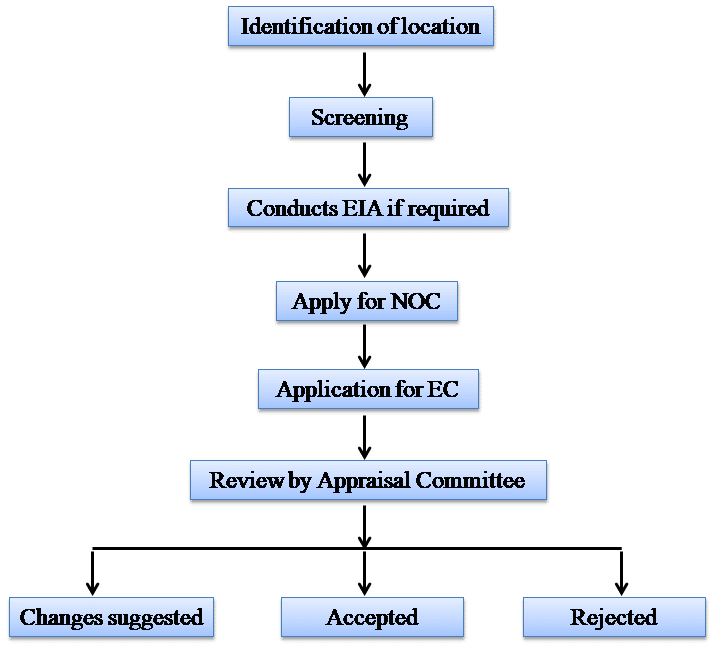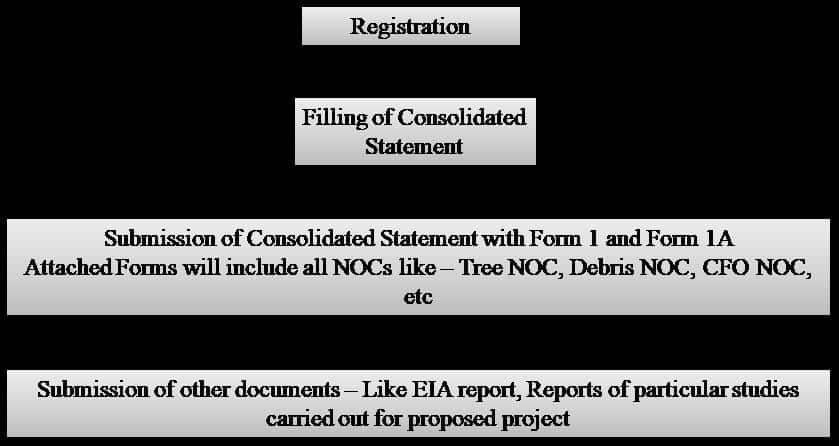Environmental Clearance
Environmental Clearance is the procedure to get clearance from the government for the installation and modification (amendment) of certain projects. It is mandatory for projects which can cause high environmental Pollution. Indian Constitution made a list of those projects under EIA Notification 2006, which includes mining, thermal power plant, infrastructure, etc.
What is Environmental Clearance?
Advent of industrialization brought many changes in our lifestyle and environment, hasn’t it? And throughout these years, the awareness towards environment and the concern for its protection has made the Indian Constitution to enforce some laws and regulation towards this matter like Environmental Clearance.

Environmental Clearance are mandatory regardless of the type of project in areas which are ecologically fragile such as – coastal area, wetlands, anthropological sites, international border areas, national parks & sanctuaries, areas of scientific and geological interests, etc.
The Central Pollution Control Board (CPCB) has also introduced a colour codification for industries depending on their impact of environment. Industries are classified on a pollution potential index as red, orange, green and white industries to differentiate environmental clearance process across categories.
| Red | Orange | Green | White |
| Pollution Index Score 60 and Above | Pollution Index Score 41 to 59 | Pollution Index Score 21 to 40 | Pollution Index Score up to 20 |
| Example: * Hazardous Chemicals Manufacturing * Lead and Battery Manufacturing * Cement Industry * Nuclear Power Plants | Example: * Bakeries and Confectionery units * Food and Food Processing including fruits and vegetables processing * Automobile Servicing, Repairing and Painting * Building & Infrastructure projects | Example: * Ayurvedic and Homeopathic medicines without boiler * Carpentry & wooden Furniture * Minerelized water * Ready Mix Concrete | Example: * Blending and packing of Tea * Cotton & Woolen Hosiers making * Organic Manure Mixing * Diesel Pump Repairing & Servicing |
There is also another index is used to calculate Air Quality Index.
Did you know industries falling under White category are those who can function without seeking Environmental Clearance?
Purpose of Environmental Clearance
The main purpose behind Environmental Clearance is to assess the impact of the proposed project on environment and people, and to try to abate or minimize the impact of proposed project on environment and people.
Learn More About Air Quality Monitoring Services Offered by Perfect Pollucon Services.
Procedure for Environmental Clearance
To get Environment Clearance for a proposed project following steps are required to be followed.

1. Identification of location
A location for the proposed project should be selected which will comply with existing guidelines. If project site does not comply with existing guidelines the proponent has to identify other alternative site for the proposed project.
2. Screening
The project proponent then will assess in which category the proposed project falls in and if it requires environmental clearance and environment impact assessment study.
There are two categories – A category and B category.
- Projects falling under A category go to MoEFCC for clearance.
- Projects falling under B category go to State government for clearance which further gets categorized into B1 and B2 projects. B2 projects do not require preparation of EIA report. But depending upon the project and its location the Appraisal Committee can ask project proponent to carry out EIA study.
3. Public hearing
The Public hearing is a mandatory step in the process of environmental clearance for certain developmental projects. It is a part of EIA study. This provides public of an area to come forward and express their concerns and views regarding the proposed project to the project proponent and the Government.
4. Application
The project proponent then has to submit an application for environmental clearance. The Application process is Online.
- The projects falling under A category will apply on MoEFCC website.
http://environmentclearance.nic.in/
- The projects falling under B category will apply on State website. For Maharashtra State, the application is done on Maharashtra Pollution Control Board‘s (MPCB) website and a new website is also been launched for the same – Parivesh.
https://www.ecmpcb.in/
Following Flow chart shows the application process

5. Environmental Appraisal
The documents submitted by project proponent will be first scrutinized by a disciplinary committee. They might also conduct a site visit if required.
In Maharashtra state, the application is first scrutinized by SEAC Committee (State Environment Appraisal Committee).
There are 3 SEAC Committee’s.
- SEAC 1 gives appraisal for projects like industries, mining etc.
- SEAC 2 Committee gives appraisal for Infrastructure projects located in Mumbai and its suburbs.
- SEAC 3 Committee gives appraisal for infrastructure projects excluding Mumbai and its suburbs.
After scrutinized by the SEAC Committee, the project if accepted will be recommended to SEIAA (State Environment Impact Assessment Authority). The project will then be scrutinized by SEIAA for the compliance points recommended by SEAC and if accepted, SEIAA will grant Environment Clearance with certain conditions.
If the conditions said in the Environment Clearance are not followed then the Appraisal Committee has the right to cancel EC granted for that project.
*The EC granted is valid for certain years depending upon the type of project. If EC is expired, the project proponent can go for renewal of EC by following the same procedure.
Now that you have got an idea about Environment Clearance and its purpose behind, you can check out status of major projects and take part in the public hearing and give your views. You can also use this knowledge before buying any property, be it your home as well.
Environmental Clearance in PDF by Perfect Pollucon Services
Appraisal and Clearance for Industry
Appraisal and clearance processes are essential components in the establishment and expansion of industrial projects. Appraisal involves a thorough examination of the proposed industrial venture, considering environmental, economic, and social factors.
Obtaining clearance, often through regulatory bodies, signifies adherence to environmental standards and compliance with legal requirements, ensuring that industrial activities align with sustainable practices and pose minimal harm to the surrounding ecosystem and communities.
Together, these processes contribute to responsible industrial development, fostering a balance between economic growth and environmental stewardship.
List of projects require Environmental Clearance
- Mining , extraction of natural resources and power generation (for a specified production capacity)
- Primary mineral Processing
- Materials Production
- Materials Processing
- Manufacturing/ Fabrication
- Service Sectors
- Physical Infrastructure including Environmental Services
- Building/Construction projects/Area Development Projects and Townships
Environmental Clearance Certificate
Before starting any new infrastructure or expansion project, Environmental clearance certificate is required from central or state pollution control board. Environmental clearance certificate signifies that particular project produce no harm to environment and society.
Perfect Pollucon services is well known organization in environment clearance space. We offer environmental management services and Environmental testing services for our clients to ensure hygienic and pollution free environment to live. Our experienced and expert staff takes care of all environmental related activities in the best possible and cost-effective manner.
Contact us for More information on Environmental Clearance process. We offer Environmental Monitoring Services
The purpose of Environmental Clearance is to assess impact of the planned project on the environment and people and to try to abate / minimize the same. it seeks to curb industries and projects that supposedly hamper the environment and living species in one way or another. It serves as a legal consent for industries that are unfriendly to environment. It has been made mandatory under Environment Protection Act, 1986.
The environmental clearance process comprises of four stages, namely: Screening, Scoping, Consultation and Appraisal.
The EIA Notification of 1994 made the environmental clearance mandatory for all new projects and expansion / modernization of existing projects covering 29 disciplines (later increased to 32 ) which included hydro-power, major irrigation and flood control projects.
Environmental Clearance is required to control industries and projects which cause harm to the environment and society. It basically serves as legal permission to the industries which cause pollution as per the Environment Protection Act 1986.
Terms of Reference (ToR) outline the scope and guidelines for an Environmental Impact Assessment (EIA) study, providing a roadmap for assessing potential environmental impacts of a proposed project.
Environmental Clearance (EC) is the formal approval granted by regulatory authorities after a comprehensive assessment, ensuring that the project complies with environmental regulations and standards.
In India, the Ministry of Environment, Forest and Climate Change (MoEFCC) is responsible for environmental clearance. Within the ministry, the Environmental Impact Assessment (EIA) Division oversees the process, ensuring that proposed projects comply with environmental regulations and undergo a thorough assessment of their potential environmental impacts.
Exemptions from environmental clearance pertain to specific categories of projects or activities that are deemed to have minimal environmental impact and are, therefore, not subjected to the comprehensive clearance process.
These exemptions, outlined in environmental regulations, typically consider factors such as the scale of the project, potential environmental risks, and adherence to specified conditions.
Projects that may pose potential environmental impacts often require Environmental Clearance (EC). These include large-scale industrial ventures, infrastructure development projects, mining activities, and any undertaking that has the potential to significantly alter the environmental landscape, as determined by the regulatory authorities overseeing environmental matters.
The validity of Environmental Clearance (EC) typically ranges from a few years to the project’s expected lifespan, as specified by regulatory authorities. It ensures ongoing compliance with environmental standards throughout the project’s implementation and operation.
Small-scale projects and activities with minimal environmental impact, such as certain types of construction projects and infrastructure activities, may be exempt from environmental clearance, depending on the regulations of the specific country. However, the exact categories exempted vary, and compliance with specified conditions is often a prerequisite.

Very useful information. Looking forward for many such blogs from you